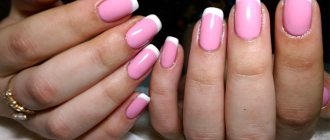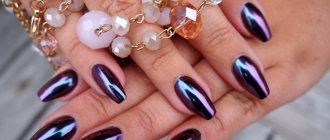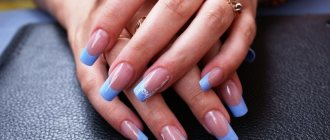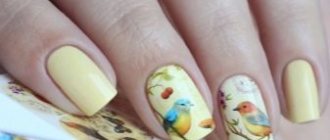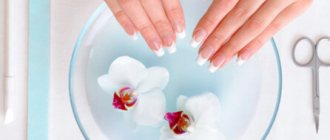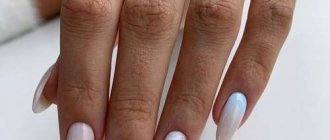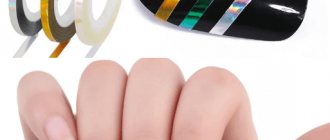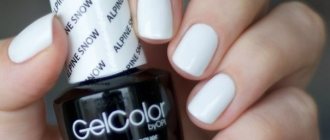Causes of fragility
Brittle nails can be caused by both external and internal reasons. After the nail is repaired and the threat has passed, be sure to analyze the situation and determine whether the reasons listed below are appropriate in your case:
- unbalanced diet and lack of vitamins. Vitamin deficiency is a common cause of fragility. The nail plate becomes thinner and becomes vulnerable to external influences - mild mechanical shocks, snags on clothing;
- mechanical impact - a one-time impact on a hard surface;
- systematic mechanical influences, for example, working on a keyboard;
- coating without a base coat;
- hand contact with high or low temperatures.
Nail structure and growth: what healthy nails and skin should look like, care rules
Nail health during manicure and pedicure: what a novice master should pay attention to
Advantages of Poly-gels for extensions
Acrylic gels carry all the advantages of individual materials: modeling, building, strengthening and design. Polygel for nail extensions is becoming the main competitor to simple gels and acrylic powders, gaining popularity among the fairer sex. The second name of this substance is combigel.
- It is absolutely safe to use, as it does not cause allergic reactions, is easy to use and work, and also does not have any effect on human health.
- Acrylic gel nail extensions ensure safe filing of excess material.
- Particles of the frozen substance are lighter than those of their predecessors, therefore they settle on the surface without flying in the air.
- When carrying out the procedure, the master does not need to perform the process quickly, because this substance does not come into contact with the skin due to its viscosity and malleability.
- When building with acrylic, it takes a little more time to dry in a lamp, but eliminates the need to measure time during this procedure.
- The extended nail is close in appearance to the natural one. The applied acrygel does not peel off, interacts well with other substances and is quite light in weight.
- In addition to the beautiful appearance, the master strengthens the nails using the constituent substances of the applied base.
If your natural nail is broken
A broken natural nail often causes more discomfort than an extended one, because it does not have protection in the form of gel, tips or other foreign materials. For repairs, silk, fiberglass or improvised material in the form of a tea bag is used.
- silk is available in dozens of brands of manicure products, for example Formula Profi;
- EMI has fiberglass. It is presented not in the form of bunches, but in a narrow strip;
Silk is easier to work with and cheaper than fiberglass, so let’s look at the instructions for repairing with silk. The technology for repairing with silk, a tea bag or fiberglass is identical.
Fiberglass: what it is, application features, step-by-step techniques
The free edge is broken
Lovers of long natural nails have at least once encountered breakage of the nail plate in the area of the free edge. The hanging part is more susceptible to stress, as it does not have a safety cushion in the form of a nail bed.
If the free edge is damaged:
- Remove the decorative covering, if any;
- Sand the nail plate with a buff, including at the break point, to remove any unevenness;
- Place a piece of silk or a tea bag on the crack and secure it with medical or special glue for silk. No superglue - it corrodes nails due to its aggressive composition. Instead of glue, you can use biogel - it is elastic and durable and can fix the damage;
- If the strip of silk lies unevenly, straighten it with an orange stick;
- Wait for the glue to dry and polish to even out the areas where the glue protrudes. If you use biogel for binding, then you need to dry it in a lamp for 30 to 120 seconds;
- For strength, you can apply another 1-2 layers of silk according to the same scheme - polishing-glue-silk;
- Finally, coat the nail plate with a textured polish, such as glitter. This varnish will hide unevenness and increase the durability of the coating.
With silk repair, you can go through 5-10 days before the next correction. By that time, the nail plate will have grown a little and it can be filed down to the broken point or strengthened again with silk.
In the center of the nail plate
A crack starting from the free edge towards the center of the nail plate usually forms on weak and thin nails. It will not be possible to trim or file it down - the nail fits tightly to the nail bed, where there are nerve endings.
To prevent the crack from getting larger and clinging to clothing.:
- Cut a piece of silk or, in extreme cases, a tea bag, so that it completely covers the crack and extends slightly beyond it;
- Gently polish the broken area with a buff;
- Apply a thin layer of medical glue or a special one for silk and place silk fabric on top;
- Apply a little more glue;
- Straighten the silk with an orange stick and wait until the glue dries;
- Polish the nail plate with a buff to smooth out the protruding glue and cover it with glitter polish or gel polish according to all the rules.
All about nail buff - types, materials, abrasiveness, how to use, how to choose
Under the “patch”, the cracked nail will gradually grow back and be filed down. But even a small crack will take 1 to 3 months to heal completely.
If it breaks in the center, it is not recommended to seal it with an adhesive plaster - a greenhouse effect is created under it, which causes the growth of bacteria. In addition, an unfixed crack may increase in size.
"Before the meat"
If the nail is broken until it bleeds, and the nail bed is damaged, this is a reason to consult a doctor. Surgeons deal with such problems, but, as a last resort, you can also contact a therapist so that he can write out a referral.
Why see a doctor:
- He will examine the nail plate and select care to prevent inflammation and infection, as well as relieve pain . In such cases, herbal baths with chamomile infusion, as well as antimicrobial and anti-inflammatory ointments, for example Levomekol, are usually prescribed;
- the surgeon will determine whether the remaining portion of the plate is viable . If the damage is serious, it may be necessary to remove its remains.
With such a serious injury, do not self-medicate - this can result in more global problems - the development of infection, serious inflammation, increased pain.
First aid for breaking the nail plate to the meat:
- Treat the injury site with chlorhexidine or hydrogen peroxide;
- Wrap your finger in a bandage and leave it alone until you see a doctor.
It is not recommended to cover the wound with a plaster - removing it will be painful. Complete restoration of the nail plate will take from 4 to 12 months, depending on the characteristics of the body.
To make regrowth happen faster:
- Lubricate the cuticle and nail bed with oil products with the function of accelerating growth, like the Levrana “Lemon Oil” brand;
- Use gloves when in contact with water and chemicals;
- Follow your doctor's recommendations for changing dressings, taking topical medications, and home care.
All about choosing and using nail and cuticle oil
You can find dozens of tips online on how to repair such a breakdown and even save your manicure. Don't use these tips - it's better to ignore the beautiful design and length and take care of your health.
How to avoid:
- watch your diet - your diet should contain vitamins of all groups, as well as minerals and trace elements. If you can’t balance your diet, buy a vitamin complex with vitamins A and E - they are responsible for the strength of the nail plate;
- use gloves when washing dishes and cleaning . Exposure to water and chemicals thins the nail plate, making it fragile and prone to breakage;
- drink water . With a lack of fluid in the body, the nail plates become thinner and dry, which increases fragility;
- Remove decorative coating correctly . Do not tear off the gel polish - use special tools or a device. When the material is peeled off, the top protective layer is separated along with it, and the nails become thin and prone to brittleness.
All products and procedures to accelerate nail growth
Possible independent actions with a broken nail
A broken nail can not only crack slightly, but also come off completely and then cause a lot of trouble: pain, clinging to everything or scratching, unsightliness, and, in the end, torn new tights.
What women should do if their nails are damaged:
- file the nail or trim the damaged edge;
- do the gluing yourself, for example, repair the nail with gel polish;
- find a good specialist who can help quickly.
There is no point in restoring a nail that is cracked by more than a third of its length. This is a repair without a time guarantee. In addition, sometimes the crack is so deep that a finger is injured. In such difficult cases, it is better to solve the problem with a specialist in a good salon.
When it comes to home repairs and saving a nail, think carefully about the gluing technology. A crack of varying sizes can run along the overhanging part, or maybe right in the middle. These are all important inputs.
If there is a slight break, the problem area is sealed with a special patch made from natural fabric. You can also use a piece of paper plaster. These methods are good if the nail is cracked on the side, along the smile line, along it.
If the extended nail is broken
Usually, extended nails on forms break, since this material is fragile compared to tips. The easiest option when such a nail breaks is to remove the material and re-build it. But if you just came from the salon and there is still a long time until the next procedure, try one of the methods presented below.
Repair with silk
Repairs with silk or its analogue in the form of a tea bag are carried out according to the same scheme as when saving natural ones:
- The affected area is filed down and covered with a silk patch coated with glue;
- After drying, the irregularities are filed with a file or buff and covered with varnish or topcoat.
The only difference is that any glue can be used for extended nail plates, since it will not come into contact with the natural nail.
Superglue
This method is used when the free edge of the extension has broken off completely.
- Take a broken piece of artificial nail and lubricate the joint with natural superglue;
- Press the piece against the broken edge and hold for about a minute so that the glue sets;
- Apply top coat to the inside of the extended nail and dry it in a lamp. Repeat this action 2 more times;
- On the front side of the nail plate, we filed away the area where excess glue appeared with a file. It is better to do this with a hard file – 150-180 grit;
- After leveling the surface, cover the entire plate with topcoat and dry it in a lamp.
Such repairs allow you to save length, but the repaired nail will be many times more fragile than all the others - keep this in mind and carefully wear your manicure before correction. The next time you go to the salon, it is better to remove the material and re-build it.
If the extended nail breaks and damages the natural one
In rare cases, this also happens - careless wearing of especially long extended nails leads to the fact that the natural one breaks or even partially moves away from the nail bed.
In this case:
- Remove any material immediately. Use acetone-free products for soaking so as not to irritate the damaged nail bed;
- Wash your hands thoroughly and treat the injury site with hydrogen peroxide;
- Apply a bandage and see a doctor.
If the break is minor, remove the coating and file off the broken natural nail. After this, the extension can be done again.
How to avoid:
- use high-quality materials from trusted manufacturers for extensions;
- reduce mechanical impact - this includes, among other things, tapping on the table with the tips of your nails;
- use gloves - under the influence of chemicals the material loses its strength;
- make the correction in time. As the extended nail plate grows, the stress zone shifts, and the risk of breaking a nail increases significantly;
- completely remove old material before applying new material.
Extensions on top forms with examples and instructions
Nail extension with tips: materials, step-by-step instructions and nuances
After care
After nail prosthetics, supervision by a podologist is required. The artificial material is worn until the healthy nail grows completely. This can take anywhere from 1 month to a year depending on the rate of growth of the plate and how much of it was lost initially. During this time, the prosthesis is corrected or replaced every 1 to 2 months.
When wearing artificial material, a gentle regime is indicated, protection from excessive loads. When getting prosthetic toenails after fungus or injury, you should temporarily avoid playing sports. They increase the load and pressure on the toes (dancing, football). And also avoid shoes with narrowed toes, as this will lead to deformation of the prosthesis and increase the treatment time.
After prosthetic nail replacement, it is very important not to allow it to touch, because in this case it will come off along with the natural nail. It is necessary to use medications at home daily, which are recommended by a specialist. It is important to treat your finger with antiseptics. To improve blood circulation and nutrition in the damaged nail bed, it is recommended to do a light massage daily at the base of the nail plate.
If your nail is broken under gel polish
- Remove the material using gel polish remover. To do this, moisten a napkin with the product and apply it to the damaged nail for 10-15 minutes;
- Wash your hands under warm running water;
- If the nail breaks off along the free edge, simply file it with a file and repeat the coating;
- If a crack appears in the center or at the base, grease a small piece of silk or a tea bag with medical glue or a special product for silk and place it on the crack;
- Wait until it dries and carefully file the patch with a 180-240 grit file or buff;
- Apply regular polish on top or do a manicure with gel polish.
How to fix a broken nail?
Breakage of the nail plate causes a lot of inconvenience and discomfort. However, there are several ways to restore its original appearance.
Natural
Clinging to various surfaces, a cracked nail on the hand can come off at any time, which will lead to bleeding and severe pain. If for some reason it is impossible to visit the salon, you need to fix the broken nail yourself.
Important! The procedures for restoring natural and extended nails are completely different. First of all, you need to remove the varnish coating from the broken nail.
To do this you will need the following tools:
First of all, you need to remove the varnish coating from the broken nail. To do this you will need the following tools:
- file;
- foil or similar material;
- orange stick for manicure;
- fat cream;
- nail polish remover;
- cotton pads.
Restoring a broken nail is carried out in several stages:
- The top layer of the coating is cut off and the top section of the nail is lightly ground down.
Cream is applied to the finger (up to the 2nd phalanx inclusive), a cotton pad is moistened in the liquid and wrapped around the finger, and wrapped with foil on top so that alcohol or acetone vapors cannot quickly evaporate. After 15 minutes, the foil, disc and gel polish coating are removed using an orange stick. All steps can be repeated again if the first attempt does not bring the desired result. - Thoroughly polish the damaged area.
- Place foil under the nail plate, having previously folded it into 4 layers or a form specially designed for nail repair. Then secure with adhesive tape.
- Degrease the nail.
- Apply primer and dry using a UF lamp.
- Apply a rubber-based base to the treated area, then apply a strip of foil to the desired length of the nail, join the sectors and also apply a layer of base on it with a thickness exceeding the thickness of the nail layer.
- Dry thoroughly under an ultraviolet lamp.
- Paint the artificial nail with gel polish in 2 layers.
- Dry under a lamp.
- Straighten the nail using a nail file and nail scissors.
You can repair a nail using a special manicure glue; if you don’t have it on hand, use its industrial analogue. The algorithm of actions is as follows:
- wash and dry your hands thoroughly;
- place the finger with the damaged nail in warm water and hold for 5-7 minutes to soften;
- dry your finger and apply a drop of glue to the nail, distributing it evenly over the nail plate;
- press for 2-3 minutes;
- eliminate excess adhesive;
- sand with a file;
- apply decorative varnish.
Extended
Restoration of extended nails is carried out in several ways, which can be used:
- special silk;
- acrylic Powder;
- tea bag;
- medical plaster;
- biogel;
- acrylic.
Important! If the damage under the shellac (natural resin) is not too severe, then filing off the nail and growing a new one is not at all necessary. Repairing a broken nail is carried out in several stages:
Repairing a broken nail is carried out in several stages:
- cut out a patch of a suitable size from a tea bag, plaster or other available material;
- glue the patch to the damaged area using glue with strong fixation;
- Apply an adhesive layer to the glued material, and after it dries, repeat the procedure several times;
- polish the restored part using a file;
- degrease, apply base, top and gel polish;
- dry in a UF lamp.
Crack on the side under the gel polish
The resulting defect can be eliminated using special glue and acrylic powder. Repairs should proceed as follows:
- remove shellac;
- degrease and disinfect;
- perform polishing;
- coat the crack and the area around it with adhesive;
- dip the finger with the cracked nail into a container of acrylic powder and leave for 2-3 minutes;
- remove excess powder and dry using a UF lamp;
- After sanding and degreasing, apply primer, base, top and gel polish.
Before applying each material, dry the previous layer well in a UF lamp.
The video clearly shows how to repair a crack on an extended nail:
What not to do
- seal a natural nail with glue - the aggressive composition of the adhesive irritates the skin and disrupts the structure of the plate. You can use glue only if the extended nail is broken;
- treat with acetone containing product . This is especially true in cases where the nail is broken “down to the meat.” Acetone is irritating and causes inflammation. In the case of extensions, it is also not recommended to use acetone - it will destroy the strength of the material and will probably catch entire nails;
- hesitate . You shouldn’t put off repairing it – careless movement of even a slightly damaged nail can result in more serious damage.
If you have questions, ask them in the comments.
And if you have no questions, just share your opinion about the article - this is very important to us. Comment
How to treat nails after injury?
Treatment depends on the type and severity of the damage. Before surgical treatment of the nail, local anesthesia is used so that the victim does not experience pain.
In case of a hematoma, a puncture is made in the nail plate to freely drain accumulated blood, eliminate throbbing pain and alleviate the condition.
The parts of the nail that are torn and peeled off after injury are removed; they do not grow back. If necessary, the skin around the nail and the nail bed are sutured, and a therapeutic protective bandage is applied.
For open wounds and a large area of damage, the doctor may prescribe antibiotic ointments.
If a bone is fractured, they are referred to a traumatologist to install a splint, fix the fragments with wire or other methods.
After treatment, you must strictly follow all of its recommendations at home, take prescribed medications and come for follow-up examinations on the appointed days.
Complete recovery of a nail after an injury takes from 2 to 6 months until a new nail grows.
With correct and timely assistance, the prognosis for treating nail injuries is generally good. The most common complication is deformation of the growing nail plate. But over time it goes away. Failure to follow proper care instructions can lead to onychomycosis or bacterial infection due to pathogenic fungi or bacteria entering the skin. With severe damage, there are cases when the nail does not grow after the injury.
To keep your nails intact and healthy, be careful and follow safety rules. Keep them trimmed short so they can't get caught on anything.
If you cannot avoid trouble, seek help immediately to reduce the risk of complications.
At the Eva Korneeva Podology Center, you can quickly get help with varying degrees of severity of injuries to your fingernails or toenails. And also learn how to grow your nails faster or temporarily disguise an existing cosmetic defect.
To make an appointment please call.
Descriptions of diseases
Simultaneous diseases of the fingernails and toenails are quite rare; usually the nails of the upper extremities are affected.
Hippocrates nails
The extreme phalanges of the fingers thicken, the nails become convex and round. Hippocrates was the first to describe this phenomenon affecting the hands, which is why it got its name. It is not an independent disease, but may appear as a symptom when:
- emphysema;
- pulmonary tuberculosis;
- long-term endogenous intoxication;
- disorders of the cardiovascular system;
- cancer, especially in the lungs.
Sometimes Hippocratic nails can be a hereditary or congenital pathology. In cancer, it develops rapidly over months or weeks; in other cases, the process of change can last for years.
Scleronychia
Hypertrophic changes occur in both the arms and legs. Nails harden, become transparent, taking on a yellowish-gray tint, and over time may separate from the nail bed. This is considered a manifestation of endocrine diseases, although the main causes of scleronychia are still not known.
Onychogryphosis
Another name is “bird's claw”. It can develop as a result of frostbite or severe bruising.
The nail becomes dense and uneven, taking on an unnatural color from gray-yellow and brown to almost black. In addition, its free edge is bent, like a bird's, or twisted into a spiral.
Treatment consists of softening the surface of the nail with a salicylic patch or ointment; in advanced cases, it can be scraped off or surgically removed.
